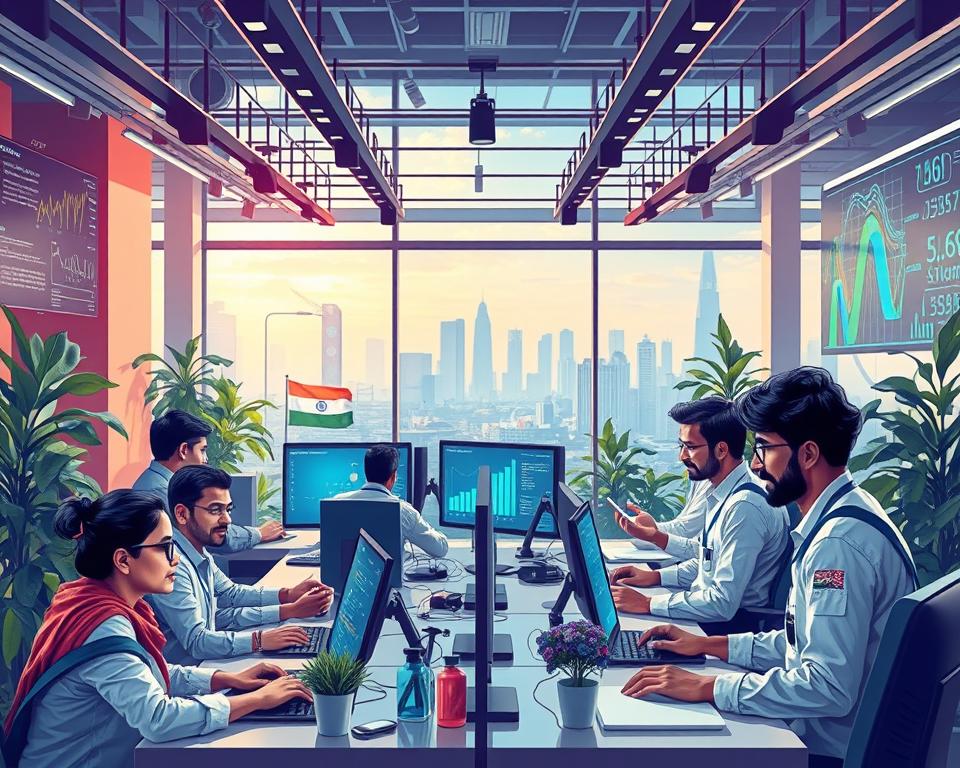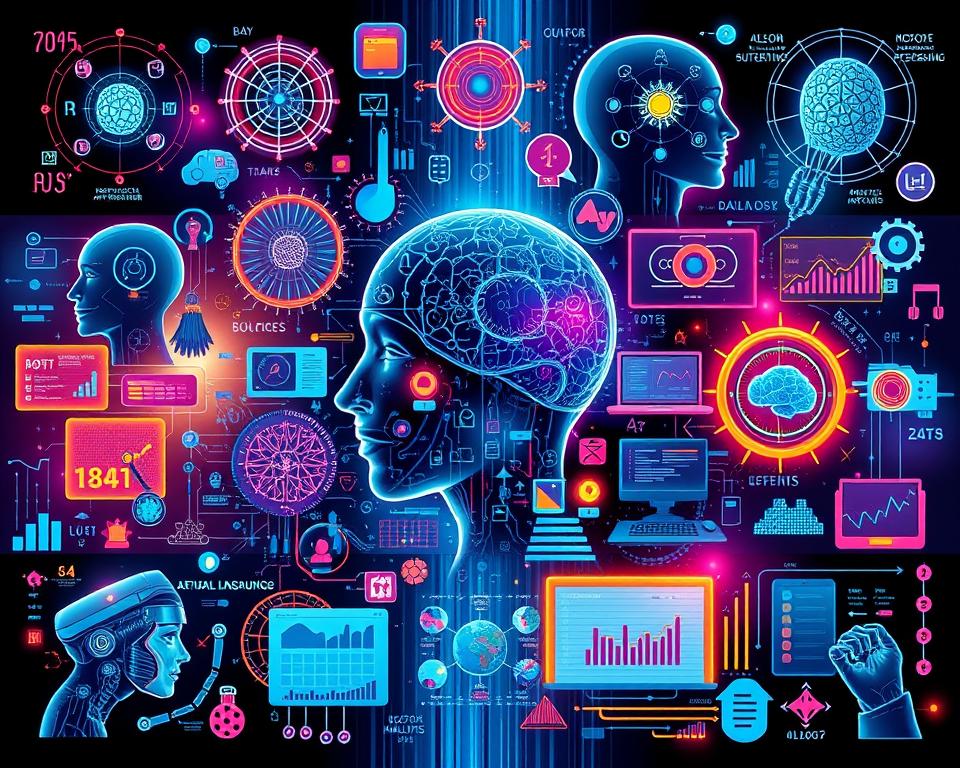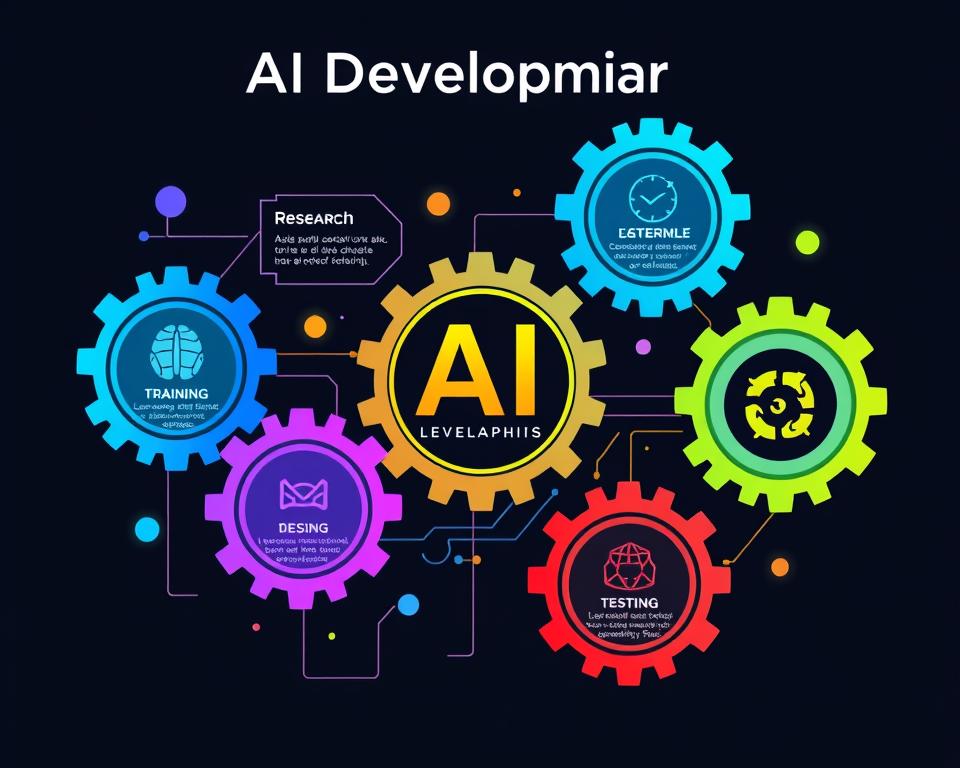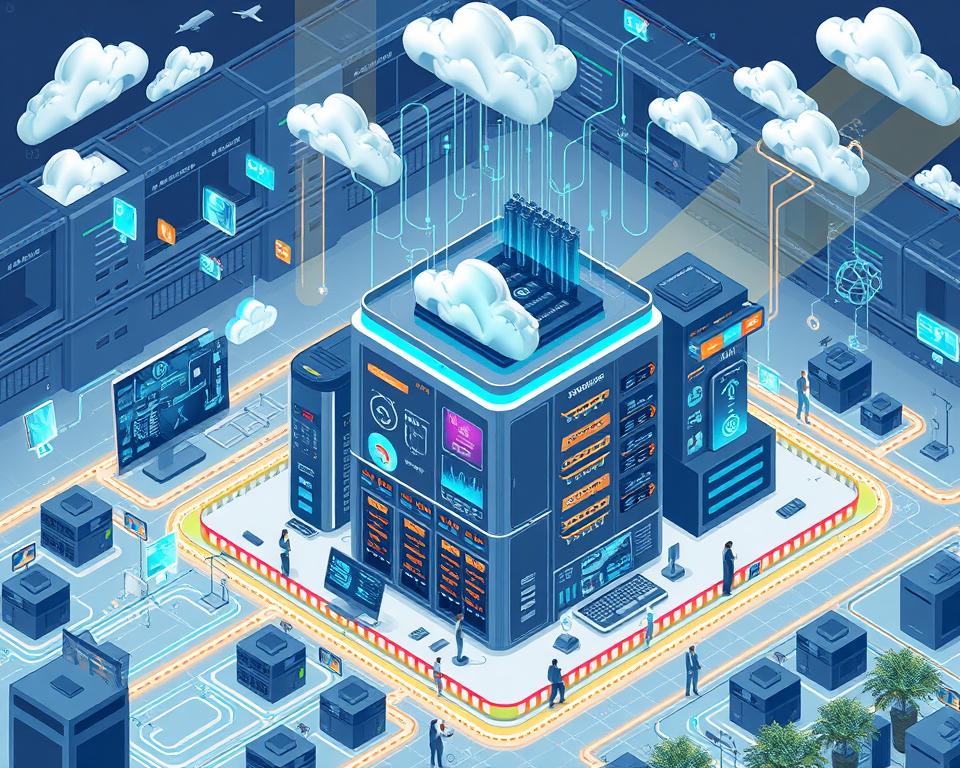India is now a key player in the world of Artificial Intelligence (AI). It has a lot of skilled tech workers, affordable development options, and a growing AI market. This makes India a great place for companies looking to use AI solutions.
This article explores the cost of AI development in India. It looks at what affects prices and how businesses can get the most value from their AI investments.
Table of Contents
Key Takeaways
- India’s AI development market offers cost-effective solutions compared to global counterparts.
- The Indian AI landscape is experiencing rapid growth, driven by a skilled talent pool and supportive government initiatives.
- Factors such as project complexity, development team structure, and technology stack significantly impact AI development costs in India.
- Cost-saving strategies, including optimal resource allocation and strategic technology selection, can help organizations maximize their ROI on AI investments.
- Understanding the nuances of AI development pricing is crucial for businesses to make informed decisions and capitalize on the opportunities in the Indian market.
Understanding the AI Development Landscape in India
The Indian AI industry has grown a lot in recent years. It has made India a key player in artificial intelligence. This growth comes from a strong tech base, a lively startup scene, and more AI experts.
Current Market Overview
The Indian AI market is set to hit $7.8 billion by 2025. This is up from $3.1 billion in 2020. This shows AI is being used more in healthcare, finance, retail, and e-commerce.
Growth Projections and Trends
- The AI market growth in India is expected to grow by 20.2% from 2020 to 2025. This is faster than the global average.
- Technologies like machine learning and natural language processing are in high demand. They are driving the need for AI solutions in India.
- Investments in AI research by governments and companies are speeding up the Indian AI industry‘s growth.
Key Players in Indian AI Development
The Indian AI industry has many leading companies. They are shaping the future of AI. Some of these companies are:
- Tata Consultancy Services (TCS)
- Infosys
- Wipro
- Tech Mahindra
- Microsoft India
- Amazon Web Services (AWS)
These leading AI companies in India are using their skills in AI. They are creating advanced AI solutions for clients worldwide.
Factors Influencing AI Development Costs
Creating artificial intelligence (AI) solutions is a complex task. The costs can change a lot based on several key factors. It’s important for businesses and organizations to know these factors before investing in AI technologies. Let’s look at the main elements that affect AI development costs in India.
Project Complexity and Scope
The complexity of an AI project greatly affects its cost. Projects with advanced features like machine learning, natural language processing, or computer vision cost more. The project’s scope, including dataset size, user number, and integration needs, also plays a big role in the cost.
Technical Requirements and Infrastructure
The choice of technology stack and infrastructure also impacts AI development costs. Needs for special hardware, cloud computing, and data storage add to the cost. Businesses must carefully plan their technical needs to budget correctly for AI success.
Talent and Expertise
Hiring experienced AI developers, data scientists, and machine learning engineers is a big cost factor. The availability and demand for skilled AI professionals in India affect labor costs. Companies need to invest in top talent for successful AI solutions.
Understanding these AI cost factors helps businesses plan and budget better for AI projects in India. This leads to more successful and cost-effective AI implementations.
“Successful AI implementation requires a careful balance of technical expertise, project planning, and cost management.”
Types of AI Solutions and Their Price Ranges
In India, the need for artificial intelligence (AI) solutions is rising. It’s key to know the various AI types and their costs. Costs vary based on project complexity and scale, from machine learning to natural language processing (NLP) and computer vision.
Machine Learning Applications
Machine learning (ML) lets systems learn and get better over time. It’s not programmed like traditional systems. ML solutions, like predictive analytics and image recognition, cost between ₹5 lakhs to ₹50 lakhs. This depends on the project’s size and how customized it needs to be.
Natural Language Processing Systems
Natural Language Processing (NLP) deals with how computers understand human language. NLP solutions, like chatbots and language translation, can cost ₹10 lakhs to ₹1 crore. This varies with complexity and the need for specific training data.
Computer Vision Solutions
Computer vision lets computers understand digital images and videos. Solutions like object detection and autonomous vehicles can cost ₹15 lakhs to ₹1.5 crore. Costs depend on project needs and the need for special hardware and algorithms.
Keep in mind, these costs are just estimates. They can change based on project complexity, the AI team’s expertise, and client needs. Talking to experienced AI providers can help understand these costs better.
“The cost of AI development is a crucial consideration, but it should be balanced with the potential benefits and long-term returns of the technology.”
AI Development cost In India
The cost of AI development in India varies a lot. It depends on the project’s size, complexity, and needs. But, India is known for offering affordable AI solutions.
Industry estimates say AI development in India costs between $10,000 and $100,000. Smaller projects with simple needs cost less. But, bigger, more complex projects can cost more.
| Project Scale | Average Cost Range (USD) |
|---|---|
| Small-scale AI projects | $10,000 – $25,000 |
| Medium-scale AI projects | $25,000 – $50,000 |
| Large-scale AI projects | $50,000 – $100,000 |
Several factors make AI development in India cost-effective. There’s a big talent pool, lower labor costs, and a growing AI ecosystem. Also, cloud computing and open-source AI frameworks help keep costs down.
For businesses wanting to use AI without spending too much, India is a great choice. It offers affordable AI solutions that can really help your business grow.
Comparing AI Development Costs: India vs Global Markets
Artificial intelligence (AI) development costs vary worldwide. India is known for its affordable AI solutions. By looking at India’s AI scene and comparing it to other places, we learn about cost benefits and what to consider.
Cost Advantages in the Indian Market
India is a top choice for AI development, thanks to its cost benefits. It has a large talent pool and lower operational costs. This makes India a great place for developing AI solutions affordably.
- Labor costs in India are lower than in the US, saving a lot on AI development costs.
- India offers AI and machine learning services at good prices, thanks to its skilled workforce.
- The Indian AI scene is growing, with many startups and providers. This competition keeps prices down for AI projects.
Quality and Expertise Considerations
While India’s AI market is affordable, quality and expertise matter too. India is known for its top-notch software development. Its AI teams are skilled in machine learning, natural language processing, and computer vision. This ensures global AI costs are matched with quality and expertise.
When comparing India vs US AI pricing, consider both cost and expertise. Working with trusted Indian AI firms offers cost-effective AI development without sacrificing quality.
Essential Components of AI Development Pricing
Building artificial intelligence (AI) solutions is complex. The costs can vary a lot. It’s important for companies to know what makes up the cost of AI development.
Labor Costs
The cost of talent is a big part of AI development. AI pricing components include the salaries of experts like data scientists and software developers. The cost can change based on experience and where they are from.
Infrastructure and Technology Costs
The tech needed for AI also affects the cost. This includes the price of special computers and the cost of using cloud services. There are also costs for data storage and software licenses.
Development Stages and Timeline
The different stages of an AI project add up in cost. From planning to deployment, each step has its own expenses. The project’s complexity and timeline also play a role in the total cost.
Research and Ongoing Optimization
AI needs constant improvement. Costs for research, data collection, and fine-tuning should be included in the budget. This ensures the AI system works well over time.
Knowing what affects AI development costs helps companies plan better. They can use resources wisely and make sure their AI projects succeed.
Timeline and Development Phases Impact on Cost
AI development’s timeline and phases greatly affect its cost. Knowing these factors is key for accurate budgeting.
Planning and Research Phase
The planning and research phase sets the AI project’s foundation. It involves checking if the project is possible, defining its scope, and doing market research. Costs here include market analysis, user research, and creating a project roadmap. Good planning in this phase can spot issues early and save money later.
Development and Testing Phase
The development and testing phase is where the AI is made and improved. This phase is the biggest cost part, covering tasks like data collection and model training. The AI model’s complexity, the dataset size, and needed infrastructure also affect costs.
Deployment and Maintenance Costs
After the AI is made and tested, it’s time for deployment and maintenance. This includes hosting, scaling, and keeping the AI system running smoothly. Costs for ongoing maintenance, updates, and infrastructure changes add up over time.
Understanding how these phases affect AI development costs helps businesses plan better. They can manage their budgets, use resources wisely, and make smart decisions throughout the project.
| Development Phase | Key Cost Considerations |
|---|---|
| Planning and Research | Market analysis, user research, project roadmap development |
| Development and Testing | Data collection, model training, iterative testing |
| Deployment and Maintenance | Hosting, scaling, software updates, infrastructure upgrades |
“Careful planning and a thorough understanding of the development phases can help businesses optimize their AI development budgets and achieve long-term success.”
Hiring Models and Their Cost Implications
The choice of hiring models for AI development can greatly affect costs. Businesses in India have several options. Each has its own pros and cons.
Building an in-house AI team gives more control and customization. But, it might cost more upfront for salaries, training, and infrastructure. Outsourcing AI development to specialists can save costs and offer a wider talent pool.
A hybrid model combines in-house and outsourced resources. It balances control and cost-effectiveness. This way, businesses can use external AI experts while keeping a core team for strategy and integration.
Deciding to outsource or build an in-house AI team depends on several factors. These include project complexity, skill needs, and local AI talent availability. Evaluating these factors helps make a budget-friendly choice that fits long-term goals.
It’s key to ensure the AI team has the right skills and experience. Investing in quality talent and ongoing training is crucial. It helps manage costs and unlock AI’s full potential in the long run.
Infrastructure and Technology Stack Costs
The cost of AI development in India is greatly influenced by the infrastructure and technology stack. Cloud computing expenses and hardware needs are two key factors.
Cloud Computing Expenses
AI projects often use cloud-based platforms, leading to significant cloud computing costs. The cost depends on the cloud provider, computing power, data storage, and network bandwidth. It’s important for businesses to choose the right cloud solutions to keep AI infrastructure costs low.
Hardware Requirements
The hardware needed for AI, like servers and GPUs, can be expensive. The cost varies based on the AI model’s complexity, data volume, and system performance. Choosing the right hardware can help control hardware expenses and AI infrastructure costs.
| Cost Component | Estimated Range |
|---|---|
| Cloud Computing Expenses | ₹50,000 – ₹5,00,000 per month |
| Hardware Requirements | ₹5,00,000 – ₹50,00,000 (one-time investment) |
Understanding and managing AI infrastructure costs is crucial. It helps businesses optimize their AI development budgets and use resources efficiently.
AI Development Team Structure and Costs
Creating a successful AI team in India needs a careful look at the right mix of skills. An AI team usually has different roles, each with its own salary and skill needs.
Key Roles and Costs
- Data Scientists – They handle data, prepare it, and develop models. Salary range: ₹8-20 lakhs per year.
- Machine Learning Engineers – They make AI models ready for use. Salary range: ₹10-25 lakhs per year.
- AI Architects – They design the AI system’s overall structure. Salary range: ₹15-35 lakhs per year.
- Computer Vision Specialists – They create advanced computer vision algorithms. Salary range: ₹12-30 lakhs per year.
- Natural Language Processing (NLP) Experts – They work on language understanding and generation. Salary range: ₹12-30 lakhs per year.
- AI Researchers – They explore new AI methods and technologies. Salary range: ₹20-50 lakhs per year.
An AI team also needs support from software engineers, UI/UX designers, and project managers. They help with integration and deployment.
The cost of an AI team in India can change a lot. It depends on the project’s complexity, the needed skills, and the team’s experience. Finding the right talent and team structure can make AI development more affordable.
Cost-Saving Strategies in AI Development
AI is now key to business success, and companies are looking for ways to save money. They want to keep quality and function high without spending too much. By smartly using resources and picking the best tech, they can cut costs in AI projects.
Optimal Resource Allocation
Managing resources well is key to saving on AI costs. This means:
- Checking the project’s needs to use resources wisely
- Using in-house skills to cut down on outside help costs
- Using agile methods to work better and waste less
- Looking at affordable cloud options for computing needs
Technology Selection Tips
The tech you choose can greatly affect AI costs. Here are some tips for picking wisely:
- Looking at open-source options for cheaper alternatives
- Choosing tech that grows with your project and is easy to keep up
- Picking tech that fits your project’s needs to avoid extra costs
- Going for tech that’s easy to change and adapt to new needs
By smartly managing resources and choosing the right tech, companies can save a lot on AI cost optimization. They can keep up with resource management and technology choices needed for AI success.
Maintenance and Support Costs
AI development doesn’t stop after the project is done. You’ll face AI maintenance expenses and long-term costs for ongoing support. These costs can add up fast, so it’s key to plan for them early on.
Keeping an AI system running means regular updates, bug fixes, and checks on how it’s doing. Users might also need special help to keep it working well. The AI maintenance expenses depend on how complex the system is and how much support it needs.
| Cost Component | Average Cost Range |
|---|---|
| Software Updates and Maintenance | 10-20% of initial development cost annually |
| Technical Support and Helpdesk | $50-$150 per hour, depending on expertise |
| System Monitoring and Performance Optimization | 5-10% of initial development cost annually |
Remember to include these ongoing support and long-term costs in your AI project budget. Not doing so can lead to surprise expenses and cost overruns later on.
Understanding and planning for an AI system’s whole life cycle helps organizations make better choices. This way, they can make sure their AI development investment pays off as expected.
ROI Considerations for AI Development Investment
Investing in AI development is a big step. It’s important to know the potential return on investment (ROI). The costs at first might seem high, but the long-term gains can be much greater. Let’s look at the ROI for AI, including short-term and long-term benefits, and the special advantages for each industry.
Short-term vs. Long-term Returns
The ROI of AI can be seen in two ways: short-term and long-term. In the short term, AI can make things run smoother, decisions faster, and work more efficiently. These quick wins can give you a fast return on your investment. But AI’s real strength is in its long-term impact.
In the long run, AI can save a lot of money, grow revenue, and give you a competitive edge. It can automate tasks, make workflows better, and uncover deeper insights from data. This leads to big improvements in profits and market position.
Industry-specific Benefits
The benefits of AI ROI differ a lot between industries. For example, in healthcare, AI can spot diseases early and treat them more accurately. This can save lives and cut healthcare costs. In finance, investment returns can go up with AI’s help in managing portfolios, spotting fraud, and giving personalized advice.
In manufacturing, AI can make production better, improve quality, and manage the supply chain. This leads to more efficiency and cost savings. The industry-specific AI benefits keep growing as the tech gets better.
In conclusion, the ROI of AI is complex. It needs a deep look at both short-term and long-term gains, and the special benefits AI offers to each industry. By carefully thinking about these, companies can make smart choices and fully use AI’s potential as a strategic investment.
Common Pitfalls in AI Development Budgeting
Creating an artificial intelligence (AI) solution is complex and expensive. It’s key to steer clear of common budgeting mistakes. These can cause cost overruns and delays in projects. In India, some common errors in AI budget planning include:
- Underestimating Project Scope: Not fully understanding the size and complexity of an AI project can lead to big budget mistakes. This can cause cost overruns and delays.
- Neglecting Infrastructure Costs: Ignoring the costs for hardware, software, and cloud computing can leave a big hole in the AI development budget.
- Insufficient Resource Allocation: Not realizing the need for experts like data scientists and AI architects can lead to budget problems and project hurdles.
- Undervaluing Maintenance and Support: Not setting aside money for ongoing maintenance and support can lead to unexpected costs. This can threaten the long-term success of the AI solution.
- Lack of Contingency Planning: Not having a plan for unexpected changes or technical issues can make the AI development budget unstable.
To avoid these mistakes and ensure a successful AI project planning, it’s crucial to work with experienced professionals. Also, conduct thorough market research and create a detailed budget. This budget should cover all parts of the AI development process.
Conclusion
India’s AI development is growing fast, making AI solutions more affordable. The country has a lot of skilled engineers. This means businesses can get AI at lower prices than elsewhere.
The future of AI in India looks bright. The market is expected to grow a lot in the next few years. Startups and big tech companies are bringing in new AI solutions for many industries.
By using AI in India, companies can find cost-effective ways to grow. This helps them stay ahead in the digital world. It opens up new chances for growth and innovation.



















